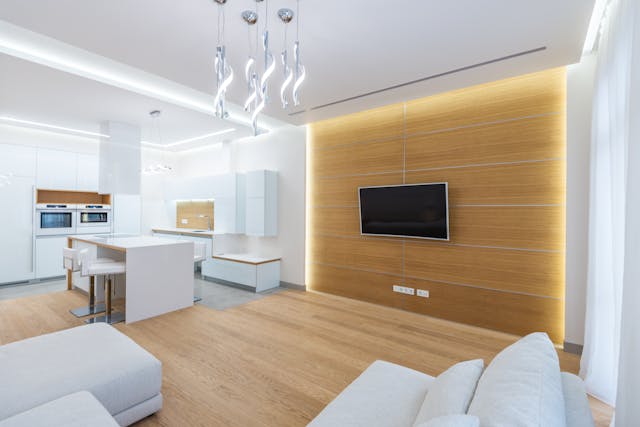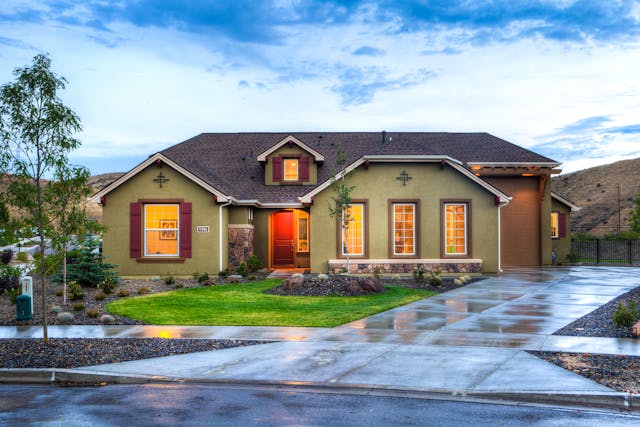- Building an energy-efficient home can be budget-friendly, leveraging sustainable design, high-performance materials, and efficient appliances to significantly reduce energy costs and environmental impact.
- Key strategies include designing a tight building envelope, using energy-efficient windows and doors, and selecting high-efficiency HVAC systems to maintain optimal indoor climate control.
- Incorporating renewable energy solutions like solar panels and tankless water heaters enhances sustainability and can lead to substantial long-term savings.
- Smart home technology and water conservation practices such as low-flow fixtures further increase efficiency and reduce resource use.
- For existing homes, upgrades like adding insulation, updating HVAC systems, and replacing windows with ENERGY STAR®-certified products can significantly improve energy efficiency.
How to Build a Budget-Friendly, Energy-Efficient Home
With energy costs climbing by over 20% globally in the past year, the appeal of traditional homebuilding is dwindling, making it clear why learning how to build an energy efficient home is more crucial than ever. As the environment bears the brunt of inefficient energy practices, the shift towards sustainable living is not just a trend but a necessity.
This blog post is designed to guide you through the process of constructing a budget-friendly, energy-efficient home. Whether you’re planning to build from the ground up or incorporate energy-saving features into your existing structure, this guide is tailored for homeowners who are eager to reduce their carbon footprint without breaking the bank. Embracing sustainable home design isn’t just about utility savings—it’s about creating healthier living spaces and contributing to environmental preservation.
The benefits of building an energy-efficient home extend far beyond mere cost savings. Such homes typically feature enhanced comfort due to stable indoor temperatures, thanks to energy-efficient building materials and smart design choices like passive solar design and well-planned HVAC systems. By choosing to build a home that respects and utilizes these principles, you not only ensure a sustainable future but also invest in a property that holds enduring value in the face of rising energy prices.
Understanding Energy Efficiency in Homes
Energy efficiency in homes is crucial for reducing utility bills and lessening environmental impact. As technology advances, homeowners have new opportunities to modify or build their homes to be more energy efficient. This guide will explore key concepts and practical steps toward optimizing home energy use, focusing on why energy efficiency matters and how to implement it through building design and system upgrades.
The Why and How of Energy Efficiency
Energy efficiency in homes is about maximizing the use of every unit of energy. By improving energy efficiency, homeowners can significantly reduce their utility bills and lower their environmental footprint. This concept extends beyond just using energy-saving appliances; it involves a comprehensive approach that includes enhancing the building’s envelope and systems to minimize energy waste.
Understanding and implementing energy efficiency requires a holistic view. It’s not only about choosing the right technologies but also about integrating them into a cohesive system that supports sustainability. This approach considers all parts of the home, from insulation and window placement to the type of heating system, ensuring that every element contributes to a more energy-efficient living environment.
Demystifying the Building Envelope
The building envelope includes all the physical barriers between the interior and exterior of your home—walls, roof, foundation, windows, and doors. These components play a crucial role in maintaining energy efficiency by controlling heat transfer. Properly designed and insulated, they can keep homes warmer in the winter and cooler in the summer, reducing the need for excessive heating or cooling.
Heat transfer through the building envelope occurs via conduction (through materials), convection (through air leaks), and radiation (from the sun). Effective insulation reduces conduction, well-sealed edges prevent convection, and reflective materials or strategic shading can minimize radiation impacts. Understanding these mechanisms helps in designing a home that naturally maintains a comfortable temperature.
Choosing Energy-Efficient Systems
Selecting the right systems for heating, ventilation, air conditioning (HVAC), water heating, and lighting is vital for an energy-efficient home. These systems are among the largest energy consumers in a household. Opting for high-efficiency models can lead to substantial energy and cost savings over time.
The importance of energy-efficient systems extends beyond just selection; proper installation and maintenance are crucial to ensure they operate at peak efficiency. For example, an improperly installed HVAC system can leak air and drastically reduce efficiency, negating the benefits of choosing a high-efficiency model. Thus, it’s essential to work with qualified professionals and consider energy efficiency ratings when selecting and installing home systems.
Building Your Budget-Friendly Energy-Efficient Home
Creating a budget-friendly, energy-efficient home begins with meticulous planning and smart choices in construction and utilities. This guide covers essential strategies to achieve efficiency from the ground up. Starting with the initial design phase, we’ll discuss how to construct a tight building envelope, select the best windows and doors, and choose efficient HVAC and water heating systems. Additionally, we’ll explore cost-effective lighting solutions. Each step is designed not only to save on initial costs but also to ensure long-term savings through reduced energy consumption, making your home as sustainable as it is comfortable.
Start Smart: Planning for Efficiency
Starting your energy-efficient home project effectively begins with a thoughtful approach to design, focusing especially on integrating passive solar design for beginners. Careful consideration of site selection, floor plan optimization, and solar strategies can dramatically improve your home’s energy efficiency from the outset.
To optimize your home’s energy performance from the outset, consider these detailed planning tips:
Site Selection
- Evaluate the sun exposure throughout the year to maximize natural light and solar gain.
- Analyze local wind patterns to enhance natural ventilation, reducing the need for mechanical cooling.
- Choose a site that allows for the integration of outdoor living spaces with the home’s overall energy design.
Floor Plan Optimization

- Design compact floor plans that are easier to heat and cool.
- Arrange living spaces to take advantage of the sun’s path for heating and lighting.
- Place utility and storage areas in less sun-exposed sections of the home to act as buffers against heat loss.
Passive Solar Design Techniques

- Utilize south-facing windows to increase solar gain in colder months while minimizing exposure during hot periods.
- Install roof overhangs or awnings to provide shade during summer and allow sunlight in the winter.
- Incorporate materials with high thermal mass, like concrete or brick, in floors and walls to absorb and slowly release solar heat.
Building a Tight Envelope: Sealing the Deal
Creating a tight building envelope is essential for maintaining energy efficiency in your home. This involves using advanced materials and techniques to ensure that heat and cool air stay inside, reducing the load on your heating and cooling systems.
High-Performance Insulation

- Opt for insulation with high R-values to maximize resistance to heat flow, such as spray foam, rigid foam boards, or blown-in cellulose.
- Consider the specific needs of each part of your home, using thicker, more resistant insulation in areas prone to greater heat loss.
Air Sealing Strategies
- Employ caulking and weather-stripping around doors and windows to prevent air leaks.
- Use spray foam insulation to seal gaps and openings in the building structure, such as where plumbing and electrical services enter.
Addressing Thermal Bridges
- Identify areas where materials that conduct heat bypass the insulation, like metal window frames and concrete floor slabs.
- Use insulating materials around these points or incorporate thermal breaks to minimize heat transfer and improve overall envelope performance.
Choosing the Right Windows and Doors
Selecting the right windows and doors is crucial for enhancing your home’s energy efficiency. These components are significant factors in controlling your home’s climate and ensuring that energy isn’t wasted.
Window Type:

- Opt for double-paned, low-emissivity (Low-E) windows which reflect heat back into the room during winter and keep the heat out during summer.
- Choose the right type of window for your climate—solar gain coefficients and U-factors are key metrics to consider.
Door Insulation and Air Sealing

- Select doors with high insulation values; look for options that include polyurethane foam cores.
- Ensure proper installation with tight seals to prevent air leakage, using weather stripping and caulking as necessary to enhance performance.
Energy-Efficient HVAC Systems: Beyond the Basics
Choosing the right HVAC system is more than just picking an energy-efficient model; it’s about understanding the features that contribute to overall energy conservation and climate control in your home.
High-Efficiency Furnaces and Air Conditioners
- Look for units with high SEER (Seasonal Energy Efficiency Ratio) ratings, indicating superior energy efficiency.
- Consider models with variable-speed drives that adjust airflow to meet demand, improving comfort and reducing energy consumption.
Heat Pumps
- Heat pumps offer heating and cooling in one efficient package, making them ideal for climates with moderate heating and cooling needs.
- Assess whether a heat pump’s efficiency, measured by HSPF (Heating Seasonal Performance Factor), fits your regional climate and energy goals.
Proper Ductwork Design and Sealing
- Ensure that ducts are designed to minimize sharp bends and long runs, which can reduce efficiency.
- Seal all ductwork meticulously to prevent air leaks, as these can significantly undermine the system’s efficiency and your home’s comfort levels.
Hot Water on Demand: Saving Energy and Money
Efficient hot water systems are essential for cutting energy costs and increasing the eco-friendliness of your home. Exploring different heating options can provide you with continuous hot water while also saving money.
Tankless Water Heaters
- These systems heat water directly without the need for a storage tank, offering energy savings by eliminating the standby energy losses associated with traditional tank heaters.
- Consider the higher upfront installation costs and ensure your home meets the higher flow rate requirements for optimal operation.
Solar Water Heating Systems
- Solar heaters use solar panels to gather and convert sunlight into heat, which is then transferred to water stored in a tank.
- While initial setup costs can be significant, the long-term savings and low environmental impact often outweigh the initial investment, especially in sunny climates.
Lighting the Way to Efficiency
Effective lighting strategies are key to enhancing both the energy efficiency and ambiance of your home. By selecting the right lighting solutions, you can dramatically reduce energy consumption while still enjoying beautifully illuminated spaces.
LED Lighting

- LEDs are highly recommended due to their long lifespan and significant energy savings compared to traditional bulbs. They also offer advanced features like dimming capabilities, allowing for further energy conservation and mood setting in any room.
Daylight Harvesting Strategies
- Utilize techniques such as placing windows and skylights strategically to maximize the use of natural light during the day.
- Consider using light shelves and reflective surfaces to enhance daylight penetration and distribution throughout your home, reducing the need for artificial lighting.
Living Green: Sustainable Practices for Your Home
Embracing sustainable practices within your home is not just about saving money; it’s about contributing to a healthier planet. Integrating a home solar power system can be a significant step towards self-sufficiency and reducing your environmental footprint.
Energy-Efficient Appliances
Investing in ENERGY STAR®-certified appliances is crucial for any eco-friendly home. These appliances use less energy and water than standard models, which helps reduce utility bills and conserve natural resources.
Here are some ENERGY STAR®-certified appliances that can help make your home more energy-efficient:
-
Refrigerators
ENERGY STAR®-certified refrigerators are significantly more energy-efficient than standard models and can reduce energy usage by 9% or more.
-
Dishwashers
These use advanced technology to minimize water and energy consumption while still delivering efficient cleaning performance.
-
Washing Machines
ENERGY STAR® washing machines use about 25% less energy and 33% less water than non-certified models.
-
Dryers
These often feature moisture sensors to reduce running time and energy use by ensuring clothes don’t over-dry.
-
Air Conditioners
Certified models have higher seasonal energy efficiency ratios (SEER) and energy efficiency ratios (EER), making them more than 15% more efficient than standard models.
Smart Home Technology:
Smart thermostats and lighting controls can significantly enhance your home’s energy efficiency. These devices automate heating, cooling, and lighting, adjusting dynamically to your lifestyle and usage patterns, ensuring energy is not wasted.
Water Conservation
Installing low-flow fixtures like showerheads, faucets, and toilets can drastically reduce water usage. Combine these with practices such as fixing leaks promptly and using water-efficient gardening techniques to maximize your conservation efforts.
Renewable Energy Sources
Consider incorporating renewable energy sources such as solar panels or small wind turbines. These systems can provide clean energy directly to your home, decreasing reliance on fossil fuels and reducing your carbon footprint. Even small-scale installations can contribute to significant energy savings over time.
Frequently Asked Questions
How much does it cost to build an energy-efficient home?
Building an energy-efficient home typically costs 0-20% more than standard homes, varying by location, size, and features like solar panels or high-grade insulation.
Will an energy-efficient home pay for itself?
Yes, energy-efficient homes can pay for themselves over time, typically in 3-15 years, depending on energy savings and available government incentives.
What if I’m renovating an existing home?
For renovations, consider energy-efficient upgrades like adding insulation, upgrading HVAC systems, and replacing windows with ENERGY STAR®-certified products.
People Also Ask
What are the benefits of a green home?
Benefits of a green home include lower energy costs, increased comfort, higher resale value, and reduced environmental impact.
What are some energy-efficient building materials?
Energy-efficient building materials include insulated concrete forms, spray foam insulation, double-paned windows, and reflective roofing.
Conclusion
In summary, learning how to build an energy efficient home involves careful planning, selecting the right materials, and incorporating efficient systems that reduce energy use and costs. These homes not only offer long-term financial savings but also enhanced comfort and a significant reduction in environmental impact. For those ready to take the next step, consider reaching out to local builders who specialize in energy-efficient construction or seeking further guidance through resources dedicated to sustainable building. Engaging in a free consultation can also provide personalized insights tailored to your specific needs and goals.
Resources
Energy Efficiency – US Department of Energy (DOE)
https://www.energy.gov/eere/energy-efficiency-buildings-and-industry
HVAC – US Department of Energy (DOE)
https://rpsc.energy.gov/tech-solutions/hvac
Passive Solar Design – US Department of Energy (DOE)
https://www.energy.gov/energysaver/passive-solar-homes
Energy Star Appliances – Energy Star®
Passive Solar Design – National Renewable Energy Laboratory (NREL)
https://www.nrel.gov/research/re-passive-solar.html
HVAC Systems – Energy Codes
https://www.energycodes.gov/sites/default/files/2021-07/TechBrief_Factsheet_HSP_1.pdf
Benefits of a green home – Greenbuilt.org
https://www.greenbuilt.org/about/importance-of-green-building/
Energy efficient building materials – US Department of Energy (DOE)
https://www.energy.gov/eere/buildings/articles/chapter-6-materials


